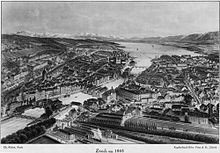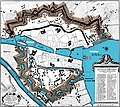Paper mill
The Papierwerd or sometimes Papierwerd-Insel was an island in the Limmat in the city of Zurich until 1950 .
Surname
Werd goes back to the Old High German word werid or the Middle High German value , the «island, river island; Low between rivers and lakes »meant. The name Papierwerd refers to the Zurich paper mill that stood on the island for centuries.
history
On May 15, 1320, the "Werdsteg" was first mentioned in a document, which as a lower mill bridge connected the right bank of the Limmat ( Limmatquai ) with the five former mills on the river island. On this, among other things, powder and paper mills were located, as can already be seen on the Murer plan (1576) by Jos Murer . The mills in Limmat and Sihl belonged to the extensive property of the Fraumünster Abbey in the Middle Ages .
In the middle of the 16th century, Christoph Froschauer held the lease of the municipal paper mill on the Papierwerd. When the third city fortification was built from 1642 to the middle of the 18th century , the paper mill was included in the fortification of the Schanzengraben .



On August 29, 1865, the “Aktiengesellschaft der mechanical paper factory on the Sihl” contracted to the municipality of Zurich “ ... to cede the piece of garden land called zum Papierwerd so that a public promenade can be built there. No high-rise buildings should be erected on this area ... »
In 1882 Josef Weber built the “Bazaar without Borders” on the Papierwerd, which later became the Globus department store .
On September 12, 1948, the town's electorate accepted the loan for the redesign of Bahnhofplatz , Bahnhofbrücke and Leonhardplatz , which later became Central. The loan of CHF 10.65 million was approved with a plus of 68%.
In 1950 the department store and the covered Brüggli near the “Du Pont” restaurant were demolished and the drained Limmatarm was converted into a street underpass; Papierwerd was no longer an island. This work was a prerequisite for the new construction of the Zurich railway station bridge.
In 1951, a planned new building for the Globus department store, in order to gain a free space on the Limmat, was rejected in a referendum. Instead, a temporary solution was built to enable the department store to be rebuilt at its new location.
In the fall of 1967 Globus left the provisional facility on the Papierwerd and the idea of a youth center on the Bahnhofbrücke, which had existed since the 1950s, came up again. At a plenary meeting on the weekend of June 14th and 15th, 1968, the progressive workers and students (FASS) demanded that the city make the vacant "Globusprovisorium" or a comparable building available as a youth center by July 1st, 1968. Shortly before, on June 13th, the city council announced that the temporary Globus facility of the ETH and the Zurich Food Association (LVZ, Coop since 1969 ) will be rented out. Since the city council no longer wanted to dissolve the contract, a rally took place on Saturday, June 29th, which finally culminated in the so-called Globuskrawall , the climax of the Zurich riots in 1968.
Directly above the Papierwerd, the connection was closed in 1982 with the new Mühlesteg , which had been missing since the upper (1943) and lower (1949) Mühlesteg were demolished in the same context ("free Limmat").
Projects
Countless projects for the use, conversion and re-use of Papierwerd have been launched over the past hundred years.
- A “house bridge” between the station bridge and a new Beaten bridge roughly in the location of today's Mühlesteg was planned by Bischoff and Weideli in 1915/18 on behalf of the city and canton.
- City architect Friedrich Wilhelm Fissler and Prof. R. Rittmeyer took up this idea again independently of one another in 1943/45. In the Schweizer Baublatt, Fissler was of the opinion that with a transverse building as a new building for the globe, the spatial appearance could be preserved.
- Other projects come from Dolf Schnebli , Ralph Baenziger , Claudia Bersin , Esther and Rudolf Guyer (all 1979). Two more recent suggestions for use from ETH Zurich, for example, are the project ideas Art & Shopping Papierwerd-Areal and Pairi-daeza: door, gate, threshold .
So far none of this has been realized, and the Globus provisional solution is still on the paper. "... All attempts to upgrade the Papierwerd area did not fail because of the architectural visions, rather a convincing, sustainable usage concept was missing ..."
Current development
A motion submitted to the city council ( executive ) by the municipal council ( legislature ) of the city of Zurich on January 16, 2008 demanded:
"... The city council should initiate a process that leads to the planning of a system that does justice to the central location and has a use appropriate to the location"
The motion was rejected by the city council, but in its statement of June 18, 2008 to the city council:
“... The city council therefore proposes starting a process that will lead to a convincing usage concept at this central location. In a second step, the corresponding configuration can then be carried out. With this in mind, the city council will inform the city council in the postulate report about a usage concept, planning and legal framework conditions, an urban-architectural feasibility study and the associated cost estimate. The complex process should be approached carefully so that the start of a new project at this location succeeds this time. As experience shows, this will take more than two years. A usage and project proposal can be drawn up by the end of 2011. If the municipal council takes note of the report and approves it, the city council will apply in a second step for any necessary project credit "
photos
The paper mill (on the left edge of the picture) with the paper mill 1576 on the Murer map by Jos Murer
The third city fortification of Zurich in 1705 with the Papierwerd at the influence of the jagged Schanzengraben in the Limmat
literature
- Rudolf Schilling: Ideas for Zurich . Orell Füssli, Zurich 1982. ISBN 3-280-01307-0 .
- From papermaking to the Sihl: 500 years of paper manufacturing . In: Neue Zürcher Zeitung , July 7, 1971.
Web links
- Globus temporary solution: emptiness is not quality . In: NZZ , March 20, 2018
Individual evidence
- ↑ Will . In: Schweizerisches Idiotikon , Volume XVI, Column 1299 f.
- ↑ Werder. In: Jacob Grimm , Wilhelm Grimm (Hrsg.): German dictionary . tape 28 : Weh – Wendunmut - (XIV, 1st section, part 1). S. Hirzel, Leipzig 1955 ( woerterbuchnetz.de ).
- ^ Stephan Bopp: Worth, Werth, Werd and Werder , Canoonet
- ↑ Gang dur alt-Züri: The lower Mühlesteg with wooden bridge , accessed on November 12, 2008
- ↑ Certificate IB 103.:15 ( page no longer available , search in web archives ) Info: The link was automatically marked as defective. Please check the link according to the instructions and then remove this notice. City Archives Zurich; Retrieved November 12, 2008
- ↑ Redesign of Bahnhofplatz and Leonhardsplatz in Zurich . In: Schweizerische Bauzeitung . 1948, doi : 10.5169 / seals-56796 .
- ↑ Voting date: September 12, 1948. In: Voting Database. Office of the President of the City of Zurich, accessed on August 26, 2019 .
- ↑ Dominique Wisler: Three groups of the new left in search of the revolution . Seismo-Verlag, Zurich 1996, ISBN 3-908239-25-7 , p. 68 .
- ^ Rudolf Schilling: Ideas for Zurich.
- ↑ Hallocity: Mühlesteg ( page no longer available , search in web archives ) Info: The link was automatically marked as defective. Please check the link according to the instructions and then remove this notice.
- ^ Alfred Cattani : A Zurich temporary solution that lasts: The wrong path of the "Free Limmat" project . In: NZZ , 24./25. February 2001
- ↑ Free Limmat - cleared and dreamed of. With contemporary photos. accessed on September 5, 2018
- ^ Rudolf Schilling: Ideas for Zurich . P. 92.
- ^ Rudolf Schilling: Ideas for Zurich . P. 93.
- ^ Rudolf Schilling: Ideas for Zurich . Pp. 94-97.
- ↑ Art & Shopping Papierwerd - area . ETH Zurich, Department of Architecture, Professorship Miroslav Sik, winter semester 2001–2002; Retrieved November 12, 2008
- ↑ Door, gate, threshold (Pairi-daeza) . ( Memento of the original from October 27, 2008 in the Internet Archive ) Info: The archive link was automatically inserted and not yet checked. Please check the original and archive link according to the instructions and then remove this notice. ETH Zurich, Institute for Landscape Architecture, Professorship Günther Vogt; Retrieved November 12, 2008
- ↑ a b Answer of the city council to the motion of January 16, 2008 (PDF; 48 kB), accessed on November 12, 2008
- ↑ Zurich City Council: Motion GR-Nr. 2008/15, January 16, 2008 , accessed November 12, 2008





